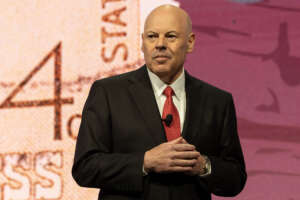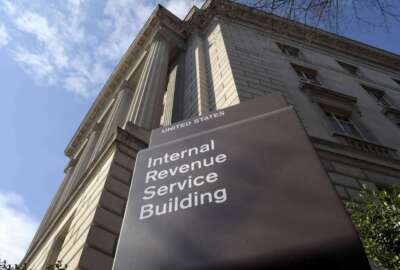DeJoy: USPS setting higher prices part of changes needed to fix ‘broken business model’
Four years into his tenure, Postmaster General Louis DeJoy is defending changes made under his 10-year reform plan — and ones still to come.
Postmaster General Louis DeJoy is billing the Postal Service’s survival from the worst days of the COVID-19 pandemic as an unsung comeback story — but the agency is still writing its next chapter, as it figures out how to stay financially healthy in the long term.
DeJoy, speaking Monday at the National Postal Forum in Indianapolis, said he inherited a “broken business model” when he took office in June 2020 — and that the agency was months away from running out of cash at the height of the COVID-19 pandemic.
“Failure to adequately adapt to social, economic, technological, and industrial changes have destroyed giants in their industry – Kodak, Motorola, Blockbuster – in just a few short years,” DeJoy said in his keynote address. “The demands of the changes experienced by the Postal Service were magnitudes greater. In addition, these organizations did not have a Congress or a regulator to contend with.”
Four years into his tenure as postmaster general, DeJoy is defending USPS changes under this 10-year reform plan — some elements of which USPS is temporarily pausing, after bipartisan scrutiny from Congress.
“The future we seek has simple goals: Evolve, serve, and create long-term viability. However, this undertaking is of historic proportion.,” he said.

Among the changes, USPS next month is increasing the price of first-class mail for the sixth time since 2020, when its regulator allowed the agency to set prices higher than the inflation rate.
USPS is also embarking on a historic reshaping of its nationwide footprint of delivery facilities — consolidating mail processing operations into large, regional hubs.
Among its goals, USPS is trying to run fewer, but fuller, trucks between facilities, and reducing its costs to deliver 123 billion pieces of mail and packages every year.
USPS is pausing some of its network modernization plans until at least January 2025, after more than a quarter of the Senate recently demanded the agency slow implementation to address persistent regional mail delays.
But DeJoy says his 10-year plan is also about making $40 billion in long-deferred upgrades to USPS infrastructure. That includes plans to roll out the country’s largest electric vehicle fleet.
“Our efforts do not come without uncomfortable consequences, to our customers, to the American people, and to our employees. But they must be made,” DeJoy said. “We are doing the necessary and important work for the nation, to develop a new path forward.”
Mail no longer a ‘sustainable monopoly’
DeJoy, in his 80-minute keynote address, outlined a widening gap between the level of service Americans expect from USPS and the agency’s ability to afford it.
USPS remains the world’s largest delivery operation, and delivers about 44% of the world’s mail. About 95% of the U.S. population lives within five miles of their nearest post office.
USPS letter carriers deliver to 167 million addresses at least six days a week, but DeJoy said more than half of those routes are losing money.
DeJoy said interventions from Congress and its regulator have made it even harder for USPS to adapt to changing times — such as a precipitous drop in mail volume in 2008 and a shipping and package boom that came with the rise of e-commerce.
In 1971, Congress spun the U.S. Post Office out from the president’s cabinet and rebranded as the Postal Service, an independent agency.
For the next 35 years, DeJoy said USPS functioned well as a “productive bureaucracy,” that primarily ran on revenue from market-dominant products, such as first-class mail.
“This at a time when the American people had plentiful demand for our services and market dominant mail volume continually grew,” DeJoy said. “Prior to 2006, our pricing was easy – just add up our cost to serve and divide it by the number of pieces – and boom – the price of a stamp — more or less”.
That all changed, when Congress passed the Postal Accountability and Enhancement Act (PAEA). Among its features, it capped USPS price increases on mail products to the rate of inflation and required the agency to refund retiree health benefits well into the future.
Congress eliminated the retirement pre-requirement in postal reform legislation that passed in 2022. But DeJoy says the intervening 15 years set USPS on a course for ruin.
“Such began the 15-year aftershock, and the fallout, which brought the Postal Service to near catastrophic failure, DeJoy said.
Under the 2006 PAEA, DeJoy said Congress limited price increases “to a fraction of what would soon be required.”
“I wonder who came up with that idea, because it had terrible consequences,” DeJoy said.
Soon thereafter, the 2008 Great Recession resulted in a 40% reduction in mail volume that never returned, hobbling the Postal Service’s main source of revenue.
“We are an organization that no longer has a sustainable monopoly,” DeJoy said. “We are an organization that now has a costly public service obligation and lacks a funding source adequate to cover the cost, in the manner that we serve. We are an organization that now must compete in the marketplace, for its customers, its revenue, and its employees. We are an organization that must accomplish our transformation, while continuing to serve the nation daily in its expansive requirements.”
Over the next 14 years following the passage of PAEA, USPS saw nearly $90 billion in losses, deferred $20 billion in maintenance costs and passed on modernization projects.
“And the losses mounted. The employees’ retirement fund got raided, the infrastructure deteriorated, the vehicles aged, the service degraded, and the bones got picked, as the organization still pursued the mission of universal service at ever-increasing costs,” DeJoy said. “The Postal Service could not possibly timely address the broad and sweeping changes required for long-term viability.”
DeJoy said these losses put USPS in survival mode and starved for cash that could have gone into pivoting in capturing more revenue from a growing package business.
“We avoided making big decisions, and we developed a strategy of simply getting through the day,” he said.
“As we were deconstructing and losing money, mail volume was rapidly declining, American homes were spreading throughout the nation, and concurrently package shipping became the new frontier.”
‘Could you do all things, at all costs, and survive?’
DeJoy said ongoing declines in mail volume require USPS to compete for a bigger share of the shipping and package business.
Even as USPS dealt with dried-up sources of revenue and billion-dollar annual net losses, DeJoy said Congress “did not change their expectations of the service obligations even a little.”
“They remained in love with the universal service mission,” DeJoy said.
DeJoy has repeatedly defended USPS’ universal service obligation to deliver mail and packages to every household in the country at least six days a week.
DeJoy told Federal News Network in April 2022 that he opposed scaling back the number of days a week USPS delivers — something the cash-strapped agency tried in 2013 — when drafting his 10-year Delivering for America plan.
“That was extremely, extremely important … you would never touch that,” DeJoy said during the interview.
DeJoy, however, has repeatedly challenged the Postal Regulatory Commission for keeping mail prices lower than it costs USPS to meet the “ever-elusive goal of the universal service obligation.”
“Universal service sounds like a requirement to do all things at all costs. Could you do it? Could you do all things, at all costs, and survive? Well, you could if enough paying customers wanted a service like that. You could, if you didn’t have any competition, and you could if the prices you charged covered all your costs, whatever they might be.”
USPS is raising mail prices for the sixth time since 2020, when the Postal Regulatory Commission gave USPS freedom to set prices higher than the rate of inflation. On July 14, USPS will raise the price of a first-class “forever” stamp from 68 to 73 cents.
DeJoy has repeatedly defended the rate hikes. He told the USPS Board of Governors in May 2022 that mail prices will need to keep going up at “uncomfortable rates,” for the agency to cover its costs and reverse the damage caused by its regulator keeping prices too low for too long.
“If I gave you a letter and 8 cents in 1971, could you get it from Bangor, Maine to Los Angeles, California in three days and cover your cost to do so?” DeJoy said.
DeJoy has butted heads with the Postal Regulatory Commission for not allowing USPS to set prices higher than the rate of inflation sooner than December 2022. That inaction, he says, cost USPS $50 billion in lost revenue over the last 15 years.
“Congress and the regulator maintained their romance of the good old days, of monopoly and bureaucracy and universal service, and resisted change despite the reducing mail volumes — despite the great recession, despite the data and reporting, despite the transparency of the crisis manifesting before them,” he said.
The Postal Regulatory Commission was widely expected to approve this summer’s price hike. But in a twist, it did tell USPS to make judicious use of its newfound flexibility to set higher prices.
“The commission strongly encourages the [USPS Board of] Governors to consider exercising their business judgment, consistent with statutory and regulatory requirements, not to increase rates by the full amount permitted by law,” the PRC wrote in its decision earlier this month.
Copyright © 2024 Federal News Network. All rights reserved. This website is not intended for users located within the European Economic Area.
Jory Heckman is a reporter at Federal News Network covering U.S. Postal Service, IRS, big data and technology issues.
Follow @jheckmanWFED






